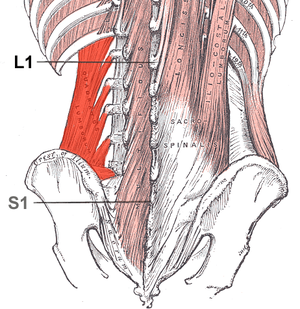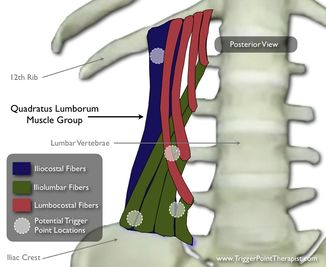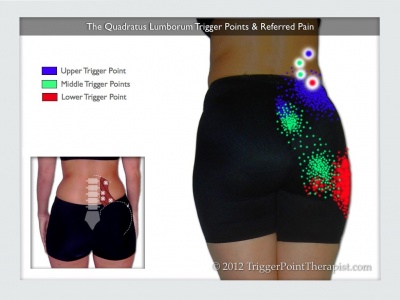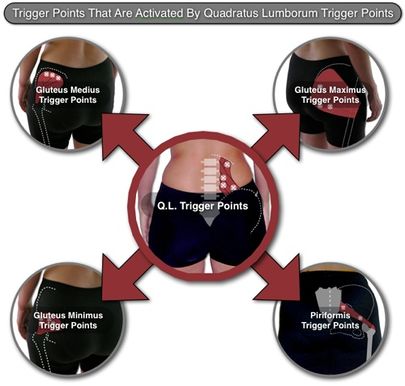Description
The word quadratus comes from the Latin word “quadrus” meaning “square” while Lumborum comes from the Latin word “lumbus” for “loin.”
A thick, irregular, quadrilateral-shaped muscle sheet that lies in the posterior abdominal wall.
Anatomy
Origin
Medial half of lower border of 12th rib and tips of transverse processes of lumbar vertebrae.[1][2]
Insertion
Iliolumbar ligament and internal lip of Posterior iliac Crest.[1][2]
Nerve Supply[1]
- Subcostal nerve (T12).
- Iliohypogastric and Ilioinguinal nerve (both from L1).
- Branches from the ventral rami (L2 and L3).
Blood Supply[3]
- Branches of the subcostal artery.
- Branches of the lumbar arteries.
- The lumbar branch of the iliolumbar artery.
- The arteria lumbalis ima from the median sacral artery.
Function
Actions[3]
- Quadratus Lumborum fixes the 12th rib to stabilize diaphragm attachments during inspiration.
- Lateral flexes the vertebral column.
- Extends lumbar vertebrae.
- It forms with the contralateral Tensor fascia lata and Gluteus medius a lateral myofascial sling which aims to maintain frontal plane stability of the pelvis.
Functional contributions
- The primary antagonist to each Quadratus Lumborum muscle is the Quadratus Lumborum muscle on the other side of the body.[4]
- The muscle group is considered a postural muscle group.
- It’s one of the muscles that tends to be tight and overactive.[5]
Trigger Point Referral Pattern
Techniques
Palpation
Related Pathologies
Dysfunction of the Lumbar structures whether degenerative, neuropathy, and/or inflammatory, may contribute to poor muscle firing and weak stabilization by the QL. [6]
Lumbar spine pathologies like bulging discs, and facet joint hypertrophy from chronic inflammation may effect nerve conduction and response to the QL and Iliopsoas resulting in poor muscle stabilization and mechanical stress from chronic contracture. [6]
Moaratty-Koehler Syndrome (MKS) is another condition related to QL dysfunction
Treatment
Resources
References
References will automatically be added here, see adding references tutorial.
- ↑ 1.01.11.2 Anatomy expert. 3D – Quadratus lumborum. Available from: ↑ 2.02.1 Keith L. , Anne M. R . Clinically Oriented Anatomy 7th edition. philidephia : Lippincott Williams & Wilkins.2017
- ↑ 3.03.1 Radiopaedia. Quadratus lumborum. Available from: ↑ Perry D. Quadratus Lumborum Trigger Points: Masters of Low Back Pain | TriggerPointTherapist.com [Internet]. Triggerpointtherapist.com. 2011 [cited 15 August 2015]. Available from: ↑ Page .P, Frank C, Lardner R. Assessment and Treatment of Muscle Imbalance: The Janda Approach .Champaign . Human Kinetics. 2010.
- ↑ 6.06.1 Acupuncture Integrated. Low Back and Lower Body Myofascial Pain Syndromes. Available from: function gtElInit() { var lib = new google.translate.TranslateService(); lib.setCheckVisibility(false); lib.translatePage('en', 'pt', function (progress, done, error) { if (progress == 100 || done || error) { document.getElementById("gt-dt-spinner").style.display = "none"; } }); }




